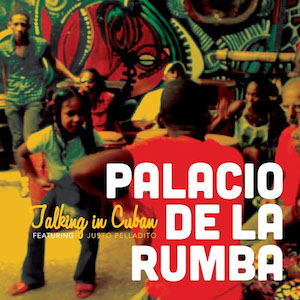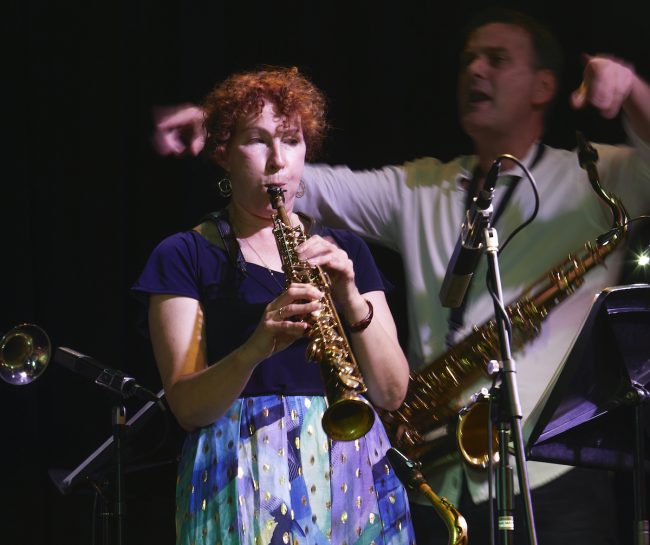Approx. 7 minute read
One of the wonderful things about working in the Arts is being surrounded by people who express their own interests and talents and share them with the world. It’s a dynamic creative space where dancers, musicians, circus performers, sculptors, painters, writers, impresarios, designers… find each other and invent ways to collaborate together.

My introduction to the saxophonist Gai Bryant was made through one of our mutual creatives, a tango aficionado and celebrator of all things art and music, Anna. Knowing that I am passionate about jazz, Anna shared Gai’s music with me; she knew I’d get the vibe of the album Talking in Cuban! Then, I had the opportunity to meet Gai and see her perform live and now, I am writing up my Shout Sister Shout interview all about Gai- so yes, I love what she is doing in music and I know you will too.
Sonia de Freitas: Hi Gai, how are you and where does our interview find you today?
Gai Bryant: I’ve just returned from visiting Candelo and Canberra with Caribé. We’ve been so lucky to be playing in regional NSW over the last few months. It’s been a great experience in every way.
On Saturday we directed workshops and performed a concert for the community of Candelo in NSW’s south east. This community, in particular, has been battered by bushfires and COVID over the past 18 months. It was special to be able to give back to them through music.
SdF: Can you tell me about your journey in music? When did you know that you were going to make music your career?
GB: I knew in high school that I wanted to be playing and involved in music-making. That journey has led to performing, touring, directing ensembles, teaching and writing music. I never felt that the skills I needed to acquire would come easily and I think that made me more determined to learn and made the journey more interesting. I enjoy learning, being curious and being able to refine what I do.

SdF: Gai, you have a particular affinity for Latin styles as shown in the incredible music for your Caribé, Palacio de la Rumba and ALLY ensembles. You also lead your own jazz Quintet that celebrates good ol’ jazz and blues with other genres thrown into the mix too. Can you tell me about your creative process when approaching your work? Are there any particular approaches you follow specific to the genres you cover?
GB: Hmmm…sometimes I’ve needed to limit myself to writing genre-specific material for a particular project. Whilst undertaking a doctorate based on Cuban traditional music blended with jazz big band I wrote a body of work that needed to retain specific forms, clave and rhythmic patterns. Every piece had specific boundaries and instrumentation. I formed 20-piece Palacio de la Rumba to play them.
Generally, my approach is quite eclectic. I’ll get inspired by a rhythm, a bass line, a fragment of melody or a harmonic sequence. That starts a process for me of figuring out which ensemble or instrumentation I’m writing for. Once you know that you know what your palette is, what your options are regards blending instruments and mutes. Next is defining the form or structure and harmony. Finally counter melodies if they’re needed and so it goes.
I’ve been fortunate that I have time to write in this way. I’m quite slow and I like to sit with ideas for little while. I’d be hopeless as a commercial composer/arranger. I’m in awe of the house composers from the Golden Years of Hollywood. Writers such as Gershwin and Bernstein generated hit songs and wonderful orchestral scores that are still loved today.
SdF: Who is your sounding board? There must be someone that you trust to give you brutally honest feedback on your music. How do they fit into the process?
GB: Sounding board? Rehearsals are a really important part of the creative development of works and ensembles. Everyone in the group wants the music to shine. I’ve found my fellow band members are fantastic at giving feedback and suggesting things if a piece is not working or could be improved. I guess they are my sounding board. I appreciate their input. They hear things differently which gives me another perspective on a problem and can open up a new direction for a chart. Sometimes as soon as you hear a tune you know what’s wrong, sometimes you need to sit with it for a while.
SdF: What was the first song that you remember making an impact in your life and why was/is it so important?
GB: Eric Dolphy’s Outward Bound album had a huge impact on me as a teenager. Eric Dolphy’s playing is so expressive and imaginative. His solos sounded fresh and unique- fingers flying, unpredictable lines. I very much wanted to follow that path.
SdF: Have you experienced particular challenges as a female musician? How did you overcome these challenges and what do you think needs to change for others to avoid these challenges in the future?
GB: I wish gender was a non-issue. It’s a bit depressing that we still need to address the challenges of being a female musician.
I do know that female players need to be visible so they can make an impact and inspire other young women to become professional musicians. There are more support systems in place to celebrate the talents of women musicians and bandleaders now however, it’s limited to a small festival once a year or a grant opportunity. To create an opportunity for Sydney’s Latin American musicians, Caribé began a Latina mentorship last year. I can’t wait to hear all the changes this will bring to the way Melody and Marina Rivera approach singing and perhaps songwriting.
Female or male we all need to be working with musicians who support our projects. Be discerning.

SdF: So, what’s on the horizon for you? Any projects you’re working on or new releases to share?
GB: Caribé has more touring coming up and ALLY has plans for some concerts in Sydney with guest drummers. Palacio de la Rumba definitely needs an outing this year. I’m hopeful that the amazing John Hoffman will come down from northern NSW and work with us.
I’ve started working with percussionist Juan Carlos Allende and pianist Daniel Pliner in a trio featuring batá drums called Wemilere Trio. We have gigs in Sydney through March at International Towers in Barangaroo and at Esteban Restaurant during March and April.
A new writing project is on the horizon that combines music and mental health. I’ll be working with interviews which is very different and exciting for me. My personal wishlist for 2021 includes recording Caribé and ALLY. I really hope we can raise the money to realise that.
SdF: What is your most memorable performance and why?
GB: Most memorable performance and tour for me was in Seoul, South Korea. I went there with my quartet featuring Lloyd Swanton and Sandy Evans. We were performing for a women’s shelter who hosted a tour for us to help them raise money for a domestic violence shelter called the House of Peace. It was an amazing tour for us and a successful venture for the House of Peace. It’s wonderful to align what you’re passionate about with a worthy cause.
SdF: Musicians come in many “flavours”; vocalists, trumpeters, bassists… ; if you weren’t a saxophonist and composer, what flavour musician would you want to be and why?
GB: Pianist. You have the entire orchestra, or big band or ensemble at your finger tips.
SdF: What advice would you give to any aspiring musicians out there?
GB: Persevere and be determined- so often, people don’t back themselves. It’s such a hard industry to be in because there are not enough opportunities and you have to work hard to create them for yourself while trying to pay your bills. Don’t wait for someone else to create an opening for you, do it for yourself when you can; strategise and plan for it.
To learn more about Gai Bryant visit: gaibryantspareparts.com
To buy Gai Bryant’s music visit: gaibryantspareparts.com/shop
To book tickets for an upcoming ALLY gig on 10 April 2021 visit: ‘Ally’ with special guests Mirko Golub Balkan Jazz Trio
For more information on International Women’s Day visit: internationalwomensday.com
Keep an eye out for my next interview in the Shout Sister Shout series where I interview Jenny Eriksson.
Did you miss the previous Shout Sister Shout instalment? Read Kristin Berardi’s interview here.
